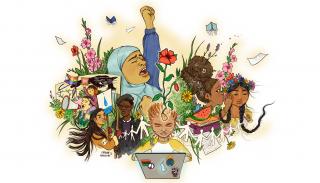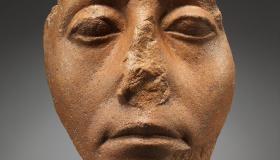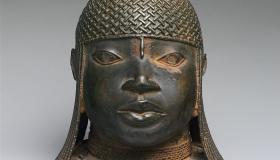
Breadcrumbs navigation
‘The Museum Will Not Be Decolonised’: The Metropolitan Museum of Art’s African Origin of Civilisation exhibition 2021-.
In late 2021, the New York Metropolitan of Art (MET) launched its ‘African Origin of Civilisation’ exhibition that paid homage to the Senegalese anthropologist Cheikh Anta Diop. Diop’s book The African Origin of Civilisation: Myth or Reality (1974) inspired a display of twenty-one object pairings from ancient Egyptian, West and Central African artefacts, to illustrate Africa’s “extraordinary creativity…across five millennia. The MET is significant because of its recognition as a, if not the, leading museum in the world. Whilst the MET is not the first museum to ‘decolonise’ curatorial practice in regard to ancient African art, as the MET’s first endeavour, the ongoing exhibition is ground-breaking.
It raises key questions: how is curatorial practice brought to establish historical continuity between ancient African pasts and Western presents? What specific ‘origin’ of civilisation is being curated? Does the exhibition correct the separation in Western museological practice of ancient Egyptian history from other ancient African pasts?
The exhibition highlights several gaps in existing academic literature, particularly pertaining to the largely disaggregated debates in existing and contemporary readings of Africa’s artistic, cultural, and political history. However, some important correctives, I argue, can be found in three key publications. Firstly, Diop (1974) argues for an African perspective on Afrocentrism. In a critique of the colonial ideas of ‘white origins’ of civilisation rooted in race science and the discipline of Egyptology; he passionately advocates for connecting West African history with ancient Egypt: “Ancient Egypt was a Negro civilisation. The history of Black Africa will remain suspended in the air and cannot be written correctly until African historians dare to connect it with the history of ancient Egypt”. Secondly, Dan Hicks (2021) argues that museums must engage with restitution to address the inherent colonial violence and trauma that exists in the sector resulting from Britain’s long history of colonial looting and cultural exploitations. Thirdly, Felwine Sarr (2019) presents a manifesto for a ‘new Africa’ that is divorced from Eurocentric epistemology, one which can empower African cultural and historical renewal and self-discovery.


Figure 1. (Left) Face of King Senwosret III, ca 1878-1840 B.C. Egyptian. (Right) Head of an Oba, 16th century. Edo artist; Igun-Eronmwen guild, Court of Benin; Nigeria. (Image credit for both images from the Metropolitan Museum of Art)
The above pairing (Figure 1) is one of the exhibition’s most controversial. It juxtaposes commemorative figures of two very different heads: an Oba or local Nigerian chief or king looted in 1897, with the great Egyptian pharoah King Senwosret II. The African cultural importance and different genealogical origins of the two rulers is effaced in a rationale that is spurious at best. Other pairings include an Egyptian Hippopotamus (1961-1878 BC) with a twentieth century Malian power object; and the Funerary Mask of Estate Manager Wah (1981-1975 B.C. Egyptian) with a Portraits Mask (Mblo), late 19th-early 20th century portrait mask (Mblo) from Côte d'Ivoire. Hicks tweets a cutting indictment: “The MET Museum’s new hyper-colonial display of Benin Bronzes/ivories juxtaposed with random objects from ancient Egypt-an idea lifted directly from the British Museum, 1899- to try to distract the audience form, y’know, restitution is the worst thing I have ever seen in a museum.”. The MET bypasses issues concerning the object’s acquisition such that an unknowing visitor would have little notion of colonial looting. The figures’ significance is for the public to imagine — a colonial assumption that no explanation was necessary to appreciate artwork from cultures outside Europe.
In sum, museums are being urged to return objects looted or stolen in the colonial era, decolonise curatorial practices, and revise relationships to their colonial legacy. Decolonisation must also involve new ways of representing the ancient histories of former colonies. Restitution is only one part of the work needed to sever museological practice from colonial legacies. The MET is guilty of wilful negligence in this regard.
Bio: Sahar Khan is an incoming postgraduate student on University College London’s MA Museum Studies course, and the recipient of the UCL Institute of Archaeology’s Heritage and Museums Opportunity Scholarship. This blog draws from her undergraduate dissertation on the BA Ancient History course at Kings College London which, due to the UCU marking boycott, is unlikely to be marked. Sarah can be reached at: sahaar.i.khan@gmail.com.
References cited:
Diop, A.C. (1974). ‘The African Origin of Civilisation: Myth or Reality’. Chicago Review Press: Lawrence Hill & Co.
Hicks, D. (2021). The Brutish Museum. London: Pluto.
Kassim, Sumaya (2017). ‘The Museum Will Not Be Colonized’. Media Diversified, 17 Nov. https://mediadiversified.org/2017/11/15/the-museum-will-not-be-decolonised/
Ryholt, B. (1997) ‘The Political Situation in Egypt during the Second Intermediate Period, c.1800-1550 B.C.’. Museum Tusculanum Press, Carsten Niebuhr Institute Publications 20. p.185.
Sarr, Felwine. (2019). Afrotopia. Minneapolis: University of Minneapolis Press.
The MET. ‘The African Origin of Civilisation’. https://www.metmuseum.org/exhibitions/african-origin-of-civilization